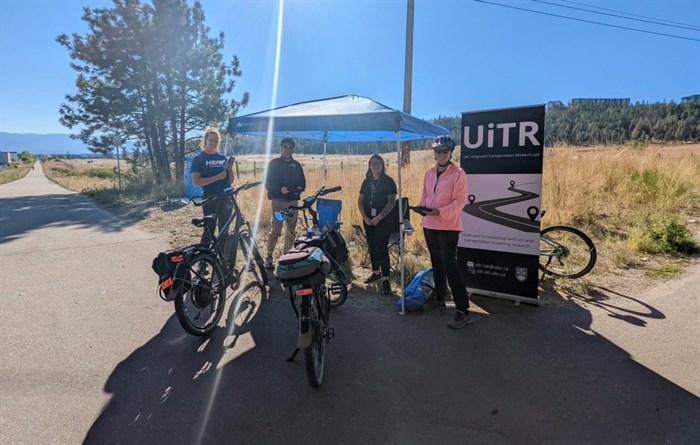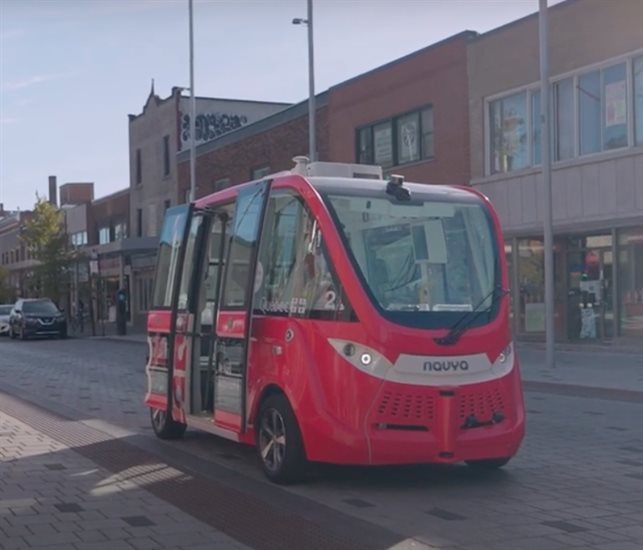Driverless bus could become part of the Rail Trail in Kelowna

A joint UBCO-City of Kelowna study on transit options for the Okanagan Rail Trail through the city is stopping users to get their thoughts.
“The need from the city was to explore the opportunity for this corridor, that is available to us, to use that for a possible deployment of autonomous transit,” Dr. Mahmudur Fatmi, associate professor in the UBCO School of Engineering, told iNFOnews.ca. “Considering that there are other modes as well – for example, walking, biking, using e-scooters, e-bikes –how can this new, futuristic mode be used along the corridor to serve the demand.”
The study started in February and will continue through to 2024.
This stage is to question users of the trail to determine things like whether it’s more for recreation, fitness or commuting.
There are eight points where users are stopped and asked to take the five-minute survey or given information on how to take it online. There are also automated counters to get an accurate number of those actually using the trail at all hours.
The survey is being conducted from 7 a.m. to 7 p.m. for a two-week period ending Sept. 29. It’s not open to non-users.
The research also includes looking at electric autonomous (or driverless) transit experiments in other parts of the world, including Calgary and Montreal, where small, 12-passenger vehicles have been tested over short routes.
READ MORE: UBCO and Kelowna looking at new ideas for Okanagan Rail Trail
Calgary’s test went from its zoo to Telus Spark in 2018 with the shuttle going 12 km/hr.
Some of the concerns from that study were the fact that the shuttle could not run during snowstorms and there was no one on board to, for example, help someone in a wheelchair to board or to provide security.
The Montreal test had two vehicles on a two-kilometre route along Rue Saint-Hubert and Rue Saint-André with speeds of 20 km/hr.
Further tests are planned for residential and commercial settings.
The Kelowna project is far from a test drive.
After the two years of study there will be enough data to determine if there is a demand for such a service and what the benefits might be.
While there may not be much traffic right now from downtown to Kelowna International Airport, 16 km away, there may be a latent demand that justifies going to the next step, Fatmi said.
“If a little faster mode of transport is deployed on this corridor, will that attract folks to use this corridor?” he said. “If you take a look at the corridor, it connects important destinations, like the airport, UBCO and downtown.”
If it becomes a commuter route, one type of vehicle might be used but if, for example, travellers want to take it to the airport there needs to be room for their luggage. It may also require space for bicycles.
This project is not to design the system but to determine if there is a demand and benefit to exploring it further.
If that happens then things like pathway width, land acquisition, leasing, costs and environmental issues will have to be studied.
The existing paved pathway is three to four metres wide but the right of way is much larger in many places.
A big part of the discussion will be whether an autonomous vehicle needs to run on a separate pathway or share space with cyclists and walkers.
Fatmi has two months to report his findings to the City of Kelowna before moving to the next phase. He’s also looking at getting federal funding for the project.
While his study is focused on the Rail Trail though Kelowna, Fatmi is well aware that this is part of a much longer trail that, someday, is expected to stretch 300 km from Sicamous to Osoyoos.
This is one of a number of joint ventures between the City and UBCO to study things like the electrification of the city’s transit fleet.
- This article was updated at 12:25 p.m., Oct. 3, 2022 to correct distance to airport.
To contact a reporter for this story, email Rob Munro or call 250-808-0143 or email the editor. You can also submit photos, videos or news tips to the newsroom and be entered to win a monthly prize draw.
We welcome your comments and opinions on our stories but play nice. We won't censor or delete comments unless they contain off-topic statements or links, unnecessary vulgarity, false facts, spam or obviously fake profiles. If you have any concerns about what you see in comments, email the editor in the link above.




